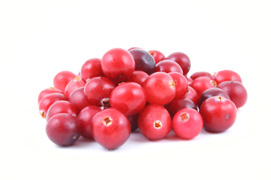Eating with a Conscience
Choosing organic food to protect health and the environment
View a different non-organic crop
 Cranberries
Cranberries
Below are the pesticides with established tolerances (residue limits for pesticides used in the U.S. or by countries exporting to the U.S.) for cranberries. While not all the pesticides on the list are applied to all cranberries, there is no way to tell which pesticides are applied to any given piece of conventional produce on your store shelf. You may consider talking to the farmers at your local farmers market about the pesticides they use, but eating organic is the only way to know for sure.
California Farmworker Poisonings, 1992–2010: Not a major California crop.
Pesticide Tolerances —Health and Environmental Effects: The database shows that while cranberries grown with toxic chemicals show low pesticide residues on the finished commodity, there are 39 pesticides with established tolerance for cranberries, 18 are acutely toxic creating a hazardous environment for farmworkers, 35 are linked to chronic health problems (such as cancer), 16 contaminate streams or groundwater, and 36 are poisonous to wildlife.
![]() Pollinator Impacts: In addition to habitat loss due to the expansion of agricultural and urban areas, the database shows that there are 20 pesticides used on cranberries that are considered toxic to honey bees and other insect pollinators. For more information on how to protect pollinators from pesticides, see Beyond Pesticides' BEE Protective webpage.
Pollinator Impacts: In addition to habitat loss due to the expansion of agricultural and urban areas, the database shows that there are 20 pesticides used on cranberries that are considered toxic to honey bees and other insect pollinators. For more information on how to protect pollinators from pesticides, see Beyond Pesticides' BEE Protective webpage.
- This crop is dependent on pollinators.

- This crop is foraged by pollinators.

(A = acute health effects, C = chronic health effects, SW = surface water contaminant, GW = ground water contaminant, W = wildlife poison, B = bee poison, LT = long-range transport)
|
Acephate Azinphos-methyl Azoxystrobin Carbaryl Chlorothalonil Chlorpyrifos Clethodim Clopyralid Cryolite Diazinon | Dichlobenil Diquat Dibromide Fenbuconazole Ferbam Folpet Fosetyl-aluminum Glyphosate Imidacloprid Indoxacarb Malathion | Mancozeb Maneb Mesotrione Metalaxyl Methoxyfenozide Napropamide Norflurazon Oryzalin Paraquat/Paraquat dichloride Phosmet | Propiconazole Pyridaben Pyriproxyfen Sethoxydim Simazine Spinetoram Spinosad Tebufenozide Thiamethoxam |
All tolerance data is based on the Environmental Protection Agency's Tolerances by Commodity, Crop Group, or Crop Subgroup Index (last updated July 2009). For more information, see our Methodology page.








